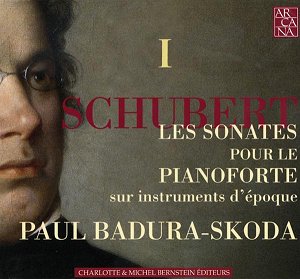|
|
Search MusicWeb Here |
|
 |
||
|
Founder:
Len Mullenger (1942-2025) Editor
in Chief:John Quinn
|
|
|
Search MusicWeb Here |
|
 |
||
|
Founder:
Len Mullenger (1942-2025) Editor
in Chief:John Quinn
|
 |
Franz SCHUBERT
(1797-1828) Sonatas for Pianoforte Sonata no. 1 in E major Sonata no. 9 in G major Sonata no. 2 in C major Sonata no. 5 in A flat major Sonata no. 10 in C major Sonata no. 7 in E flat major Sonata no. 6 in E minor Sonata no. 14 in C major Rec: December 1994, January 1996, April 1996, French Institute, Vienna. |
| CD available for post-free online mail-order or you may download individual tracks. For some labels you can download the entire CD with a single click and make HUGE savings. The price you see is the price you pay! The full booklet notes are available on-line. | |
|
NOTE • Click on the button and you can buy the disc or read the booklet details • You can also access each track which you may then sample or down load. • Further Information. |
|
|
Paul-Badura Skoda is a brilliant pianist, fortepianist and harpsichordist, who has made a number of recordings of the great repertoire for piano on "original" instruments. This set, the first of three including Schubertís piano sonatas on fortepiano, allies his excellent performances with the sound of an authentic piano, such as Schubert himself played. Far from the sound of the omnipresent Steinway that one hears on disc and on stage, the fortepiano allows the performer to develop different nuances. This instrument has a shorter sustain than the modern piano, and this alone gives the music a different sound.
Badura-Skodaís affection for this music is patent. He plays the slow movements with grace, and the fast movements with vigor, yet never overdoes the music; he keeps the music down to earth.
Where this recording stands out is in the sound of the pianoforte and how it gives the music different colors. Four different instruments are used on this recording. The opening measures of sonata no. 10, for example (as well as later sections in the same movement) take on a much more playful sound than on a modern piano, where this section can sound more dense and lugubrious.
Sample 1: disc 2 track 4 0í00"
The same is true for the beginning of sonata no. 7, where the waltz-like sound is more pronounced here than on a modern piano. Badura-Skoda seems to privilege the light, gay sounds in this music, which is often seen as turbulent and dark.
Sample 2: disc 2 track 7 0í00"
But Badura-Skoda can sound dark as well. Sonata no. 6, in E minor, played on a pianoforte with a more resounding sound, opens with some intense chords, in the first movement, the moderato, which take on a more profound sound than the other sonatas. And the long moderato, the opening movement of sonata no. 14, is indeed more tempestuous than the other works. Here, he uses the full dynamic range of his instrument, playing up a storm, yet retaining a subtle touch at times. This movement, the longest on this set at almost 15 minutes, comes alive under his fingers.
Sample 3: disc 3 track 5 0í00"
This is an essential recording of some of Schubertís piano sonatas. Both Badura-Skodaís virile and sensitive performances and the quality of the instruments he chose to record make this a delight to listen to. If you are unfamiliar with Schubertís piano music as he wrote it (on the same type of instrument he used) then this set is a must.
Kirk McElhearn |
|
ADDITIONAL INFORMATION •
You can sample only 30 seconds (or 15% if that is longer) of a given track. Select from the View tracks list. Each sample will normally start from the beginning but you can drag the slider to any position before pressing play. • PLEASE NOTE: If you are behind a firewall and the sound is prematurely terminated you may need to register Ludwig as a trusted source with your firewall software.
•You will need Quicktime to hear sound samples. Get a free Quicktime download here • If you cannot see the "Sample All Tracks" button you need to download Flash from here.
|
|
|
Return to Index |